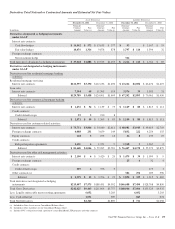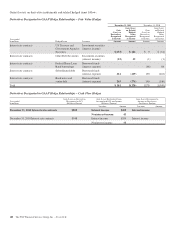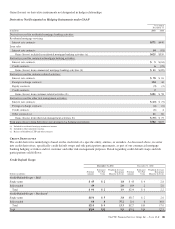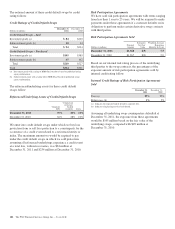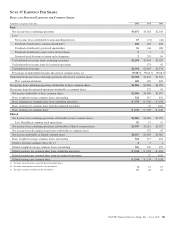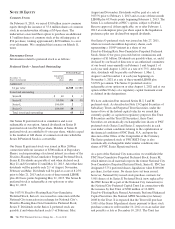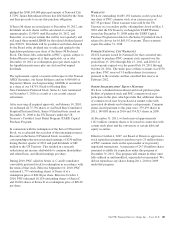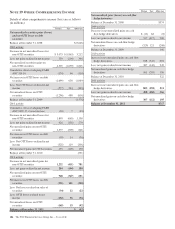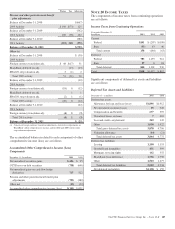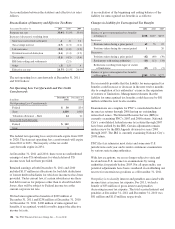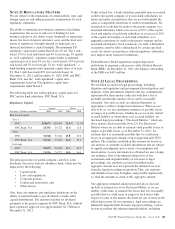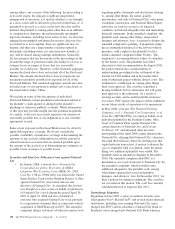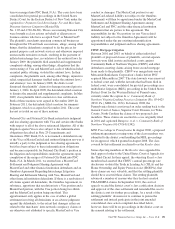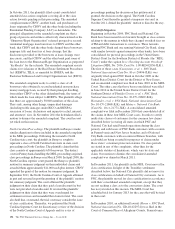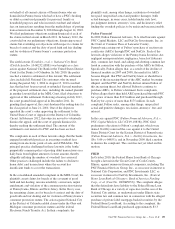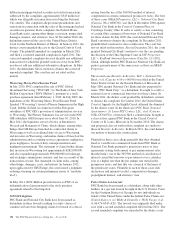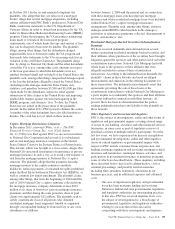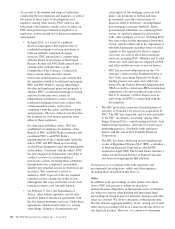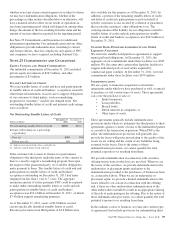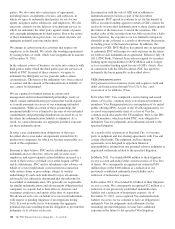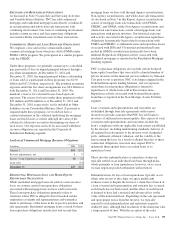PNC Bank 2011 Annual Report Download - page 198
Download and view the complete annual report
Please find page 198 of the 2011 PNC Bank annual report below. You can navigate through the pages in the report by either clicking on the pages listed below, or by using the keyword search tool below to find specific information within the annual report.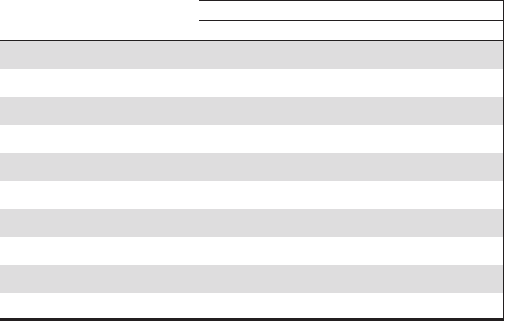
N
OTE
21 R
EGULATORY
M
ATTERS
We are subject to the regulations of certain federal, state, and
foreign agencies and undergo periodic examinations by such
regulatory authorities.
The ability to undertake new business initiatives (including
acquisitions), the access to and cost of funding for new
business initiatives, the ability to pay dividends or repurchase
shares, the level of deposit insurance costs, and the level and
nature of regulatory oversight depend, in large part, on a
financial institution’s capital strength. The minimum US
regulatory capital ratios under Basel I are 4% for Tier 1 risk-
based, 8% for total risk-based and 4% for leverage. To qualify
as “well capitalized,” regulators require banks to maintain
capital ratios of at least 6% for Tier 1 risk-based, 10% for total
risk-based and 5% for leverage. To be “well capitalized,” a
bank holding company must maintain capital ratios of at least
6% Tier 1 risk-based and 10% for total risk-based. At
December 31, 2011 and December 31, 2010, PNC and PNC
Bank, N.A. met the “well capitalized” capital ratio
requirements based on US regulatory capital ratio
requirements under Basel I.
The following table sets forth regulatory capital ratios for
PNC and its bank subsidiary, PNC Bank, N.A.
Regulatory Capital
Amount Ratios
December 31 Dollars in millions 2011 2010 2011 2010
Risk-based capital
Tier 1
PNC $29,073 $26,092 12.6% 12.1%
PNC Bank, N.A. 25,536 24,722 11.4 11.8
Total
PNC 36,548 33,724 15.8 15.6
PNC Bank, N.A. 32,322 31,662 14.4 15.1
Leverage
PNC 29,073 26,092 11.1 10.2
PNC Bank, N.A. 25,536 24,722 10.0 10.0
The principal source of parent company cash flow is the
dividends it receives from its subsidiary bank, which may be
impacted by the following:
• Capital needs,
• Laws and regulations,
• Corporate policies,
• Contractual restrictions, and
• Other factors.
Also, there are statutory and regulatory limitations on the
ability of national banks to pay dividends or make other
capital distributions. The amount available for dividend
payments to the parent company by PNC Bank, N.A. without
prior regulatory approval was approximately $1.7 billion at
December 31, 2011.
Under federal law, a bank subsidiary generally may not extend
credit to the parent company or its non-bank subsidiaries on
terms and under circumstances that are not substantially the
same as comparable extensions of credit to nonaffiliates. No
extension of credit may be made to the parent company or a
non-bank subsidiary which is in excess of 10% of the capital
stock and surplus of such bank subsidiary or in excess of 20%
of the capital and surplus of such bank subsidiary as to
aggregate extensions of credit to the parent company and its
non-bank subsidiaries. Such extensions of credit, with limited
exceptions, must be fully collateralized by certain specified
assets. In certain circumstances, federal regulatory authorities
may impose more restrictive limitations.
Federal Reserve Board regulations require depository
institutions to maintain cash reserves with a Federal Reserve
Bank (FRB). At December 31, 2011, the balance outstanding
at the FRB was $407 million.
N
OTE
22 L
EGAL
P
ROCEEDINGS
We establish accruals for legal proceedings, including
litigation and regulatory and governmental investigations and
inquiries, when information related to the loss contingencies
represented by those matters indicates both that a loss is
probable and that the amount of loss can be reasonably
estimated. Any such accruals are adjusted thereafter as
appropriate to reflect changed circumstances. When we are
able to do so, we also determine estimates of possible losses
or ranges of possible losses, whether in excess of any related
accrued liability or where there is no accrued liability, for
disclosed legal proceedings (“Disclosed Matters,” which are
those matters disclosed in this Note 22). For Disclosed
Matters where we are able to estimate such possible losses or
ranges of possible losses, as of December 31, 2011, we
estimate that it is reasonably possible that we could incur
losses in an aggregate amount of up to approximately $550
million. The estimates included in this amount are based on
our analysis of currently available information and are subject
to significant judgment and a variety of assumptions and
uncertainties. As new information is obtained we may change
our estimates. Due to the inherent subjectivity of the
assessments and unpredictability of outcomes of legal
proceedings, any amounts accrued or included in this
aggregate amount may not represent the ultimate loss to us
from the legal proceedings in question. Thus, our exposure
and ultimate losses may be higher, and possibly significantly
so, than the amounts accrued or this aggregate amount.
The aggregate estimated amount provided above does not
include an estimate for every Disclosed Matter, as we are
unable, at this time, to estimate the losses that it is reasonably
possible that we could incur or ranges of such losses with
respect to some of the matters disclosed for one or more of the
following reasons. In our experience, legal proceedings are
inherently unpredictable. In many legal proceedings, various
factors exacerbate this inherent unpredictability, including,
The PNC Financial Services Group, Inc. – Form 10-K 189


